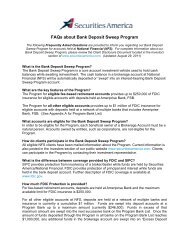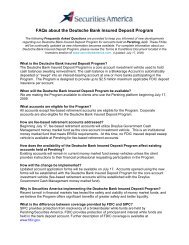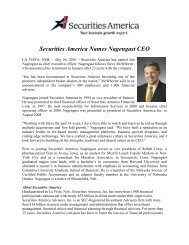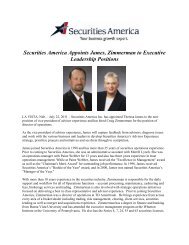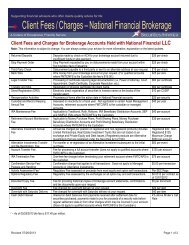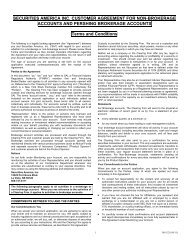Talking to Clients About Overspending in Retirement - Securities ...
Talking to Clients About Overspending in Retirement - Securities ...
Talking to Clients About Overspending in Retirement - Securities ...
You also want an ePaper? Increase the reach of your titles
YUMPU automatically turns print PDFs into web optimized ePapers that Google loves.
<strong>Talk<strong>in</strong>g</strong> <strong>to</strong> <strong>Clients</strong> <strong>About</strong><strong>Overspend<strong>in</strong>g</strong> <strong>in</strong> <strong>Retirement</strong>Your bus<strong>in</strong>ess growth expert.
<strong>Overspend<strong>in</strong>g</strong> <strong>in</strong> <strong>Retirement</strong>Table of Contents<strong>Talk<strong>in</strong>g</strong> <strong>to</strong> <strong>Clients</strong> about <strong>Overspend<strong>in</strong>g</strong> <strong>in</strong> <strong>Retirement</strong> 1Past Behavior Predicts Future Behavior 2Choice #1: S<strong>to</strong>p <strong>Overspend<strong>in</strong>g</strong> 3Choice #2: Adjust <strong>Retirement</strong> Goals & Expectations 6Choice #3: Work Longer 8Protect<strong>in</strong>g Your Practice 10Conclusion 11Appendix A: Sample Letter 14<strong>About</strong> <strong>Securities</strong> AmericaInside Back CoverCopyright November 2011, <strong>Securities</strong> America F<strong>in</strong>ancial Corporation, all rights reserved.For Broker/Dealer Use Only.
<strong>Talk<strong>in</strong>g</strong> <strong>to</strong> <strong>Clients</strong> <strong>About</strong><strong>Overspend<strong>in</strong>g</strong> <strong>in</strong> <strong>Retirement</strong>With the market decl<strong>in</strong>es of 2001-2002 and 2008-2009 and the Great Recessionstill fresh <strong>in</strong> American m<strong>in</strong>ds, and the real possibility of liv<strong>in</strong>g 20 years or more afterretirement, outliv<strong>in</strong>g retirement sav<strong>in</strong>gs has become a major concern for a grow<strong>in</strong>gnumber of adults. Yet despite their awareness, many adults with<strong>in</strong> sight of retirementexperience significant disconnects between their retirement expectations and reality.• 43 percent of Americans have less than $10,000 saved for retirement. i• 59 percent expect <strong>to</strong> receive a pension but only 41 percent can actuallyidentify a pension <strong>to</strong> which they are entitled. ii“Accumulat<strong>in</strong>g a sizableretirement portfolio doesnot mean a client willbe successful <strong>in</strong> spend<strong>in</strong>gthat portfolio wisely.”• Pre-retirees (age 50-59) expect <strong>to</strong> live about 21 years after retirement andplan <strong>to</strong> spend almost 10 percent of their sav<strong>in</strong>gs <strong>in</strong> each of those years. iii• 80 percent expect their standard of liv<strong>in</strong>g <strong>to</strong> rise <strong>in</strong> retirement. iv• 47 percent of retirees have a written withdrawal plan and only 28 percenthave a written budget for spend<strong>in</strong>g dur<strong>in</strong>g retirement. v• 49 percent of Americans are somewhat or very confident they have enoughmoney <strong>to</strong> live comfortably throughout their retirement years. viF<strong>in</strong>ancial advisors rout<strong>in</strong>ely face this disparity between clients’ expectations and theirreal life behavior, and that disconnect shows itself <strong>in</strong> clients’ spend<strong>in</strong>g habits. In a surveyconducted by Pr<strong>in</strong>cipal <strong>in</strong> June 2011, 73 percent of advisors reported “liv<strong>in</strong>g beyondone’s means” as the most common issue on which clients fail <strong>to</strong> be entirely forthcom<strong>in</strong>g. viiAccord<strong>in</strong>g <strong>to</strong> a 2005 article <strong>in</strong> On Wall Street magaz<strong>in</strong>e, f<strong>in</strong>ancial planners report hav<strong>in</strong>g<strong>to</strong> confront 10 percent <strong>to</strong> 30 percent of their clients regard<strong>in</strong>g spend<strong>in</strong>g. viiiMistakes <strong>in</strong> <strong>in</strong>vestment selection or strategy dur<strong>in</strong>g a client’s accumulation years can <strong>to</strong>some extent be offset by <strong>in</strong>com<strong>in</strong>g salary or wages. The same is true of overspend<strong>in</strong>g,which can be camouflaged by substantial <strong>in</strong>come from a job. Dur<strong>in</strong>g retirement, whennew dollars from a job have s<strong>to</strong>pped com<strong>in</strong>g <strong>in</strong>, clients may f<strong>in</strong>d their retirement portfoliocannot produce an <strong>in</strong>come equivalent <strong>to</strong> their pre-retirement earn<strong>in</strong>gs power. They maybe forced <strong>to</strong> live accord<strong>in</strong>g <strong>to</strong> a budget for the first time <strong>in</strong> their lives. Unfortunately,success <strong>in</strong> accumulat<strong>in</strong>g a sizable retirement portfolio does not mean a client will besuccessful <strong>in</strong> spend<strong>in</strong>g that portfolio wisely and <strong>in</strong> accordance with limitations like abudget.1Advisors who engage <strong>in</strong> retirement <strong>in</strong>come distribution plann<strong>in</strong>g do so <strong>to</strong> help clientsspread their nest egg across their retirement years. Client overspend<strong>in</strong>g can threatenthose plans, with significant consequences for the client and the advisor. <strong>Clients</strong> whospend at an unsusta<strong>in</strong>able rate may be forced <strong>to</strong> sell their home or take other drasticsteps <strong>to</strong> survive. Some may blame the advisor for their situation, ma<strong>in</strong>ta<strong>in</strong><strong>in</strong>g that theadvisor failed <strong>to</strong> warn them of this threat <strong>to</strong> their retirement <strong>in</strong>come or that the advisoracted <strong>in</strong>appropriately <strong>in</strong> creat<strong>in</strong>g the plan. Retired clients with no assets can makevery sympathetic witnesses <strong>in</strong> an arbitration, regardless of whether their own behavior
contributed <strong>to</strong> the situation. Advisors must address client overspend<strong>in</strong>g <strong>to</strong> protect theirclients and themselves.“The idea of transform<strong>in</strong>g a conservative portfolio … <strong>in</strong><strong>to</strong> someth<strong>in</strong>g much riskier <strong>in</strong>hopes of captur<strong>in</strong>g 11 percent a year or more horrifies prudent f<strong>in</strong>ancial planners,”writes Suzanne McGee <strong>in</strong> her article “Confront<strong>in</strong>g the <strong>Overspend<strong>in</strong>g</strong> Client.” ix “Equallyhorrify<strong>in</strong>g is the specter of what might happen if they refuse: that the client will simplywalk away and take his or her assets <strong>to</strong> a less scrupulous rival whose eyes are on the prizeof the hefty commission they can make.”Income distribution plans can also be negatively impacted by unexpected expenses,primarily healthcare, which doubles from the ages of 18-35 <strong>to</strong> the retirement years. xThose unexpected, uncontrollable expenses are outside the scope of this paper. F<strong>in</strong>ancialsupport for adult children can also derail <strong>in</strong>come distribution plans but due <strong>to</strong> thecomplex family relationships <strong>in</strong>volved, is also outside the scope of this paper. For thepurposes of this discussion, overspend<strong>in</strong>g refers <strong>to</strong> a cont<strong>in</strong>uous pattern of spend<strong>in</strong>g,characterized by difficulty differentiat<strong>in</strong>g between wants and needs, that threatens theclient’s retirement distribution plan.Past Behavior Predicts Future Behavior“Patterns of spend<strong>in</strong>gbeyond one’s meanstypically manifest longbefore retirement.”Americans tend <strong>to</strong> “want it all and want it now,” accord<strong>in</strong>g <strong>to</strong> Dan Moisand <strong>in</strong> his article“The <strong>Retirement</strong> Spend<strong>in</strong>g Debate.” xi “Juxtaposed with the fear of outliv<strong>in</strong>g one’s assetsis a concern about never gett<strong>in</strong>g <strong>to</strong> enjoy one’s assets.”Patterns of spend<strong>in</strong>g beyond one’s means, however, typically manifest long beforeretirement. Failure <strong>to</strong> address those tendencies before retirement may not becomeapparent until salary or wage <strong>in</strong>come can no longer camouflage the problem.“People may get by dur<strong>in</strong>g their work<strong>in</strong>g years based on their earn<strong>in</strong>g power. There’salways that next paycheck com<strong>in</strong>g <strong>in</strong>,” said Sharla Jessop, f<strong>in</strong>ancial advisor withSmedley F<strong>in</strong>ancial Services. “Dur<strong>in</strong>g retirement, when they are limited <strong>to</strong> the budgettheir distribution plan can support, they may have difficulty adjust<strong>in</strong>g and be prone <strong>to</strong>periods of overspend<strong>in</strong>g.”Spend<strong>in</strong>g patterns prior <strong>to</strong> retirement can also make a client comfortable with carry<strong>in</strong>gdebt. A survey by CESI Debt Solutions found that almost two <strong>in</strong> five Americans admit<strong>to</strong> accumulat<strong>in</strong>g credit card debt dur<strong>in</strong>g retirement – and are not concerned aboutpay<strong>in</strong>g it off before they die. xii Such a cavalier attitude <strong>to</strong>ward spend<strong>in</strong>g and debt canmake it difficult for clients <strong>to</strong> see outliv<strong>in</strong>g their retirement sav<strong>in</strong>gs as a real possibility.For advisors, the spend<strong>in</strong>g conversation often beg<strong>in</strong>s as part of the overall client discoveryprior <strong>to</strong> develop<strong>in</strong>g a retirement <strong>in</strong>come distribution plan. Dur<strong>in</strong>g that conversation,however, advisors may quickly f<strong>in</strong>d the need <strong>to</strong> help clients dist<strong>in</strong>guish between coreexpenses and non-essential expenses – or more simply, needs versus wants. xiii Whileclients may understand the difference on an <strong>in</strong>tellectual level, they may be unable orunwill<strong>in</strong>g <strong>to</strong> connect that understand<strong>in</strong>g <strong>to</strong> the presumably positive emotions theyexperience when they spend.2
“Because all clients are human be<strong>in</strong>gs, by def<strong>in</strong>ition they are both logical and emotional,”said Fritz Brauner, f<strong>in</strong>ancial advisor with the Brauner Company. “Deal<strong>in</strong>g with the logicalside is relatively easy for an advisor. It’s the emotional, psychological and behavioral sidethat often presents a challenge.”Not all overspend<strong>in</strong>g has its roots <strong>in</strong> an emotional or psychological need. In some cases,it may be a lack of learn<strong>in</strong>g a skill set that becomes necessary <strong>in</strong> retirement.“<strong>Overspend<strong>in</strong>g</strong> can happen for a variety of reasons, and we shouldn’t th<strong>in</strong>k the problemwill be limited <strong>to</strong> those lack<strong>in</strong>g impulse control and self discipl<strong>in</strong>e,” said f<strong>in</strong>ancial advisorSharla Jessop. “Many of our clients always made good money dur<strong>in</strong>g their careers andas a result saved a lot of money dur<strong>in</strong>g their accumulation years. This doesn’t mean theyknow how <strong>to</strong> live on a budget, someth<strong>in</strong>g that will be critical <strong>to</strong> success dur<strong>in</strong>g theirretirement, when their ability <strong>to</strong> work and earn extra money <strong>to</strong> offset excessive spend<strong>in</strong>gmay no longer be a possibility.”<strong>Clients</strong> whose spend<strong>in</strong>g threatens their retirement have three basic choices <strong>to</strong> preventthat from happen<strong>in</strong>g: 1) s<strong>to</strong>p overspend<strong>in</strong>g, 2) compromise on retirement goals or 3)work longer. Because clients used <strong>to</strong> years of overspend<strong>in</strong>g may not be able <strong>to</strong> entirelycurb those habits, a comb<strong>in</strong>ation of these approaches may prove necessary.Choice #1: S<strong>to</strong>p <strong>Overspend<strong>in</strong>g</strong>“Advisors may <strong>in</strong>accuratelyassume clients understandthe need <strong>to</strong> change or that,once change beg<strong>in</strong>s, it willbe easily susta<strong>in</strong>ed.”Two schools of thought seem <strong>to</strong> have emerged regard<strong>in</strong>g how <strong>to</strong> confront clients abouttheir overspend<strong>in</strong>g. Some advisors prefer gentle guidance, while others apply a more“shock therapy” approach by be<strong>in</strong>g blunt about the impact of overspend<strong>in</strong>g. xiv Theanswer may actually be “both,” depend<strong>in</strong>g on the client’s current stage <strong>in</strong> the behavioralchange process. xvIn the March 2011 Journal of F<strong>in</strong>ancial Plann<strong>in</strong>g article, “Motivat<strong>in</strong>g and Help<strong>in</strong>g the<strong>Overspend<strong>in</strong>g</strong> Client: A Stages-of-Change Model,” coauthors James Grubman, Ph.D.,Kathleen Bollerud, Ed.D., and Cheryl R. Holland, CFP., applied a behavioral modelpreviously developed <strong>to</strong> describe the behavior of drug or alcohol addicts. xvi Grubmanet al propose that <strong>in</strong>dividuals addicted <strong>to</strong> spend<strong>in</strong>g experience the same challenges <strong>in</strong>attempt<strong>in</strong>g <strong>to</strong> change their behavior as those struggl<strong>in</strong>g with substance addictions:denial, ambivalence, preparation, action, ma<strong>in</strong>tenance and relapse. The authors suggestadvisors may <strong>in</strong>accurately assume clients understand the need <strong>to</strong> change or that, oncechange beg<strong>in</strong>s, it will be easily susta<strong>in</strong>ed. By understand<strong>in</strong>g each stage and adapt<strong>in</strong>gtheir communication approach, advisors may be able <strong>to</strong> more successfully help spend<strong>in</strong>gaddicts change their destructive behavior.DenialAdvisors work<strong>in</strong>g with clients <strong>in</strong> the denial stage should focus on build<strong>in</strong>g rapport andhelp<strong>in</strong>g the client compare their spend<strong>in</strong>g behavior aga<strong>in</strong>st the retirement goals anddreams they identified dur<strong>in</strong>g the discovery process. Ma<strong>in</strong>ta<strong>in</strong><strong>in</strong>g a neutral and helpfulapproach provides the groundwork for the advisor <strong>to</strong> beg<strong>in</strong> educat<strong>in</strong>g the client. “Theseclients need <strong>to</strong> feel unders<strong>to</strong>od, not judged, if they are <strong>to</strong> lessen their defensiveness.”3
Brauner cited one client who faced runn<strong>in</strong>g out of money well before her life expectancyafter the market decl<strong>in</strong>es but resisted reduc<strong>in</strong>g her monthly IRA withdrawals. The clientf<strong>in</strong>ally said <strong>to</strong> Brauner, “So what you are say<strong>in</strong>g is that I am tak<strong>in</strong>g a ‘stick-your-head-<strong>in</strong>the-sand’approach <strong>to</strong> my f<strong>in</strong>ances.” xvii“The good news,” Brauner said, “is that at least she recognized her behavior for what itwas.”AmbivalenceIn the ambivalence stage, clients may acknowledge a problem with overspend<strong>in</strong>g andthe possible need <strong>to</strong> change, but they have not reached a commitment <strong>to</strong> do so. xviii Atthis po<strong>in</strong>t, logical illustrations of the consequences of overspend<strong>in</strong>g – charts, graphs,spreadsheets – may have more impact. A “summary of distributions” show<strong>in</strong>g alldistributions, with the unplanned distributions <strong>in</strong> red, may help them understand howfar they have deviated from their plan. A calcula<strong>to</strong>r that shows the time value of money– how withdraw<strong>in</strong>g an extra $1,000 per month <strong>to</strong>day impacts their plan <strong>in</strong> 25 or 30years – can help them understand the long-term consequences of their actions.Withdraw<strong>in</strong>g Too Much Too Fast?It doesn’t take very long <strong>to</strong> deplete even a significant retirement account if youwithdraw <strong>to</strong>o much <strong>to</strong>o fast.$500K$07% Withdrawl Rate6% Withdrawl Rate5% Withdrawl Rate12/3/11 2/28/23 7/31/25 10/31/31Years Income LastedYears Rema<strong>in</strong><strong>in</strong>g <strong>in</strong>a 30-Year <strong>Retirement</strong>12 14 2018 16 10“Advisors should becareful not <strong>to</strong> push theclient <strong>to</strong>o quickly <strong>in</strong><strong>to</strong>adopt<strong>in</strong>g new spend<strong>in</strong>ghabits...”This is a hypothetical illustration and does not predict or project the performance of a specific <strong>in</strong>vestment.Advisors should be careful not <strong>to</strong> push the client <strong>to</strong>o quickly <strong>in</strong><strong>to</strong> adopt<strong>in</strong>g new spend<strong>in</strong>ghabits, but <strong>in</strong>stead help the client reach the decision <strong>to</strong> change rather than cont<strong>in</strong>uecurrent habits. Ambivalent clients need <strong>to</strong> have someone acknowledge both sides of theargument <strong>in</strong> their head and their heart. xix<strong>Clients</strong> <strong>in</strong> the ambivalent stage may respond more <strong>to</strong> “shock therapy” statements thanthey did <strong>in</strong> the denial stage. Some examples of statements advisors use <strong>to</strong> shock clients<strong>in</strong><strong>to</strong> change <strong>in</strong>clude:• Please <strong>in</strong>dicate the date on this calendar when you want <strong>to</strong> receive your lastdistribution check.4
• What are you go<strong>in</strong>g <strong>to</strong> do when you run out of money?• What will it feel like <strong>to</strong> ask a friend or family member for money so youcan eat?• Do you th<strong>in</strong>k it will be easier <strong>to</strong> get a job at age 75 or <strong>to</strong> cut back a littlenow?• Which of your children are you plann<strong>in</strong>g <strong>to</strong> live with when your moneyruns out? Have you spoken <strong>to</strong> them <strong>to</strong> see if that’s go<strong>in</strong>g <strong>to</strong> be okay? Howdo you th<strong>in</strong>k that will impact their family?“By ask<strong>in</strong>g shock<strong>in</strong>g questions, I want the clients <strong>to</strong> feel <strong>in</strong> their gut what it will be like<strong>to</strong> run out of money,” said f<strong>in</strong>ancial advisor Sue Brauner, Fritz’s bus<strong>in</strong>ess partner. “I askthe questions as gently as I can, but you need that shock <strong>to</strong> get through <strong>to</strong> the clients.”PreparationAs clients decrease denial and resistance and <strong>in</strong>crease talk<strong>in</strong>g about the negativeconsequences of their spend<strong>in</strong>g, the advisor can beg<strong>in</strong> mov<strong>in</strong>g them <strong>in</strong><strong>to</strong> the preparationstage. Gett<strong>in</strong>g <strong>in</strong>put from the client on how they can change their behavior will <strong>in</strong>creasetheir buy-<strong>in</strong> and the likelihood they will follow through dur<strong>in</strong>g the action stage.In prepar<strong>in</strong>g an action plan, clients and advisors may consider emotional-based <strong>to</strong>ols suchas therapy or more <strong>in</strong>tellectual or logical <strong>to</strong>ols like budget<strong>in</strong>g. For further <strong>in</strong>formationon these <strong>to</strong>ols, please refer <strong>to</strong> the “Involve a Therapist” sidebar below and the “Help<strong>in</strong>g<strong>Clients</strong> Prepare a Spend<strong>in</strong>g Plan” sidebar on page 7.“Gett<strong>in</strong>g <strong>in</strong>put from theclient on how they canchange their behavior will<strong>in</strong>crease their buy-<strong>in</strong> andthe likelihood they willfollow through dur<strong>in</strong>g theaction stage.”Action, Ma<strong>in</strong>tenance & RelapseDur<strong>in</strong>g implementation of the change plan, advisors assume the role of partner andcollabora<strong>to</strong>r, provid<strong>in</strong>g regular summaries of the client’s progress on both the spend<strong>in</strong>gmodification plan and the overall retirement plan. xx Advisors should help the clientth<strong>in</strong>k through additional actions if life events – such as a marriage, divorce or death –occur that could potentially derail their progress. Advisors should also be prepared forrelapses and help the client exam<strong>in</strong>e what caused the relapse and how <strong>to</strong> get back ontrack.“Just as mistakes are part of learn<strong>in</strong>g any new behavior, relapses reveal much-needed<strong>in</strong>formation about what was not adequately anticipated, what skills need specialattention, and what risks are most likely <strong>to</strong> derail this <strong>in</strong>dividual client.” xxiTipInvolv<strong>in</strong>g a Therapist<strong>Clients</strong> who spend out of an emotional need may requiremore help than advisors are will<strong>in</strong>g or able <strong>to</strong> provide. Spend<strong>in</strong>g behaviorsthat evolve out of family conflict may be the most difficult for advisors <strong>to</strong>address. Enlist<strong>in</strong>g the help of a mental health professional may help theadvisor better serve clients’ needs and change their destructive behavior.5
“Many clients who are attempt<strong>in</strong>g <strong>to</strong> leave addictive spend<strong>in</strong>g beh<strong>in</strong>d willdisclose emotional issues you may feel uncomfortable handl<strong>in</strong>g at times… The best approach is <strong>to</strong> <strong>in</strong>volve a mental health therapist (not <strong>in</strong>steadof your services but <strong>in</strong> collaboration with your services), address<strong>in</strong>g theclient’s emotional issues while still pursu<strong>in</strong>g good f<strong>in</strong>ancial strategies.” xxiiAdvisors should give thought <strong>to</strong> how they will <strong>in</strong>corporate the therapist<strong>in</strong><strong>to</strong> the client relationship. This may depend <strong>to</strong> some extent on theclient and the situation. Will the therapist be present at client meet<strong>in</strong>gs?Will the therapist’s fee be passed on <strong>to</strong> the client or absorbed as part ofthe advisor’s overhead?Advisors should <strong>in</strong>terview several therapists before <strong>in</strong>volv<strong>in</strong>g them <strong>in</strong>the client relationship or referr<strong>in</strong>g clients <strong>to</strong> them. The advisor andtherapist should have strong rapport and mutual respect. Therapists witha background <strong>in</strong> f<strong>in</strong>ances may be particularly suitable for work<strong>in</strong>g withclients with emotional overspend<strong>in</strong>g problems.Choice #2: Adjust <strong>Retirement</strong> Goals & ExpectationsStephen L. Deschenes labeled the effect of uncontrolled discretionary spend<strong>in</strong>g dur<strong>in</strong>gretirement as lifestyle risk. “Lifestyle risk relates <strong>to</strong> how most people want <strong>to</strong> enjoycerta<strong>in</strong> hobbies and activities dur<strong>in</strong>g retirement but may have <strong>to</strong> cut back their standardof liv<strong>in</strong>g because they haven’t adequately planned for the <strong>in</strong>come needed <strong>to</strong> support theirdesired lifestyle. Sun Life’s Unretirement Index found lifestyle risk <strong>to</strong> be a real concernfor a lot of <strong>in</strong>dividuals. Eighty percent of those people who plan <strong>to</strong> work at the age of 67stated it was <strong>to</strong> earn enough money <strong>to</strong> live well.” xxiiiWhen one of Brauner’s clients, follow<strong>in</strong>g significiant drops <strong>in</strong> his IRA balance <strong>in</strong> 2000-2002 and aga<strong>in</strong> <strong>in</strong> 2007-2009, refused <strong>to</strong> lower withdrawals or <strong>in</strong>crease <strong>in</strong>come <strong>to</strong> avoidthe possibility of runn<strong>in</strong>g out of money, he <strong>to</strong>ld Brauner, “When I retired from thephone company, I promised myself I would never work aga<strong>in</strong>.”“He had decided that work<strong>in</strong>g aga<strong>in</strong> once he had retired was someth<strong>in</strong>g he was nevergo<strong>in</strong>g <strong>to</strong> do, no matter how dire the situation,” Brauner said.A retiree who moved from California <strong>to</strong> Florida <strong>to</strong>ld Brauner, “If you live <strong>in</strong> Florida,you have <strong>to</strong> have a boat.” The client bought an expensive boat, which came with higherexpenses and less <strong>in</strong>come. When gas prices soared some years later, he couldn’t afford <strong>to</strong>use the boat and tried <strong>to</strong> sell it – but couldn’t, as other boaters faced the same dilemmaover gas prices. The client realized <strong>to</strong>o late the need <strong>to</strong> adjust his retirement expectations– own<strong>in</strong>g a boat – <strong>in</strong> accordance with the spend<strong>in</strong>g rate his retirement distribution plancould support.“Like any skill, liv<strong>in</strong>gwith<strong>in</strong> a spend<strong>in</strong>g plantakes practice for thosewho have never done itbefore.”Like any skill, liv<strong>in</strong>g with<strong>in</strong> a spend<strong>in</strong>g plan takes practice for those who have never doneit before. F<strong>in</strong>ancial advisor Patricia Laramore, owner of Premier Investment Advisory,uses what she calls a “prenuptial.” She helps pre-retirees create a budget and live with<strong>in</strong>6
it for several months before they retire. By test<strong>in</strong>g the spend<strong>in</strong>g plan for several monthsbefore retirement, the client and the advisor get an idea of how realistic the spend<strong>in</strong>gplan will be for the client dur<strong>in</strong>g retirement.“We ask them <strong>to</strong> organize six months of expenses and <strong>to</strong> create a budget based on acerta<strong>in</strong> withdrawal rate from their current retirement sav<strong>in</strong>gs,” Laramore said. “We havethem pledge <strong>to</strong> abide by the budget for three months, and if they can, then they canactively consider retirement. At the end of three months, most of them say, ‘What wasI th<strong>in</strong>k<strong>in</strong>g? I can’t retire yet.’”The ability <strong>to</strong> track <strong>in</strong>come and expenses and balance the two <strong>to</strong> the greatest benefitseems <strong>to</strong> be a skill set that has eluded many adults approach<strong>in</strong>g retirement. Longevitytrends, however, demand a more conscientious approach <strong>to</strong> retirement spend<strong>in</strong>g. Becausethe word “budget” might meet with mental resistance from a client, some advisors havebegun us<strong>in</strong>g the phrases “written spend<strong>in</strong>g plan” or “formal spend<strong>in</strong>g policy” <strong>to</strong> describea thoughtful approach <strong>to</strong> expenses and spend<strong>in</strong>g expectations.“The trend I believe will have the most impact on the clients of f<strong>in</strong>ancial planners is the<strong>in</strong>creas<strong>in</strong>g use of formal written spend<strong>in</strong>g policies <strong>to</strong> help educate, set expectations andmanage withdrawals effectively,” Moisand said. xxiv“Advisors who encounterclient resistance <strong>to</strong>suggestions for curb<strong>in</strong>gspend<strong>in</strong>g may want <strong>to</strong>enlist the help of theclient’s accountant orestate at<strong>to</strong>rney.”Receiv<strong>in</strong>g the same <strong>in</strong>formation from multiple sources re<strong>in</strong>forces a person’s belief <strong>in</strong> thevalidity of that <strong>in</strong>formation. Advisors who encounter client resistance <strong>to</strong> suggestions forcurb<strong>in</strong>g spend<strong>in</strong>g may want <strong>to</strong> enlist the help of the client’s accountant or estate at<strong>to</strong>rney.The accountant can re<strong>in</strong>force differentiation between wants and needs, the importanceof adher<strong>in</strong>g <strong>to</strong> a spend<strong>in</strong>g plan and the consequences of cont<strong>in</strong>ued overspend<strong>in</strong>g. Anestate at<strong>to</strong>rney can help the client understand that uncontrolled spend<strong>in</strong>g will jeopardizethe client’s plans for leav<strong>in</strong>g a legacy <strong>to</strong> their heirs or charitable organizations. The keyis <strong>to</strong> help the client more solidly feel the disconnect between their current behavior andtheir long-term goals.TipHelp<strong>in</strong>g <strong>Clients</strong> Create a Spend<strong>in</strong>g PlanIn the article, “Pre-plann<strong>in</strong>g Advice,” author PamelaChristensen lists four steps <strong>to</strong> budget coach<strong>in</strong>g: gather<strong>in</strong>g<strong>in</strong>formation, track<strong>in</strong>g expenditures, develop<strong>in</strong>g and document<strong>in</strong>g thebudget, and creat<strong>in</strong>g a follow-up plan. xxv While many professionals startwith a monthly spend<strong>in</strong>g plan, start<strong>in</strong>g with an annual budget may bemore effective. Accord<strong>in</strong>g <strong>to</strong> U.S. News & World Report, xxvi a study ofcollege students showed they underestimated monthly expenses by 40percent but overestimated their annual expenses by 30 percent – mean<strong>in</strong>gtheir annual budget proved more accurate and conservative than theirmonthly budget.Most processes for creat<strong>in</strong>g a spend<strong>in</strong>g plan <strong>in</strong>clude hav<strong>in</strong>g the clientwrite down each expenditure. A higher-tech option is for the client<strong>to</strong> use only a debit card for one month, then use their bank’s account7
management platform or an account aggregation website <strong>to</strong> categorizeand <strong>to</strong>tal expenses.Another approach is <strong>to</strong> have the client set as many bills as possible onau<strong>to</strong>pay from their bank account. They then get a set amount of cash,divided per week or per month, <strong>to</strong> use for discretionary expenses. Receiptsfrom those expenses go <strong>in</strong> the envelope, help<strong>in</strong>g the client visualize theexchange of cash for those expenses.As the study of college students suggests, a s<strong>in</strong>gle month’s worth of expensetrack<strong>in</strong>g may not provide enough <strong>in</strong>formation <strong>to</strong> address overspend<strong>in</strong>gissues. For emotional overspenders, keep<strong>in</strong>g a diary or journal <strong>in</strong>conjunction with track<strong>in</strong>g spend<strong>in</strong>g can help identify situations orfeel<strong>in</strong>gs that trigger overspend<strong>in</strong>g. Develop<strong>in</strong>g a realistic spend<strong>in</strong>g plan,therefore, may require several months.Just as a sound weight loss plan doesn’t encourage fast<strong>in</strong>g or completelycutt<strong>in</strong>g favorite foods from the start, a spend<strong>in</strong>g reduction plan may bemost successful when undertaken gradually. <strong>Clients</strong> may choose a certa<strong>in</strong>type of expense <strong>to</strong> reduce or elim<strong>in</strong>ate, like go<strong>in</strong>g from a cappucc<strong>in</strong>oevery day <strong>to</strong> once or twice a week, or may do better by sett<strong>in</strong>g a dollaramount, which works well with the discretionary cash envelope methoddescribed above. As clients ma<strong>in</strong>ta<strong>in</strong> their spend<strong>in</strong>g plan, they can shiftthose funds <strong>to</strong> regular deposits <strong>to</strong> sav<strong>in</strong>gs or <strong>in</strong>vestment accounts.Choice #3: Work Longer<strong>Clients</strong> often reach the decision <strong>to</strong> delay retirement when they understand the spend<strong>in</strong>glevel their retirement sav<strong>in</strong>gs can support. Laramore’s “prenuptial budget” exercisetypically results <strong>in</strong> clients decid<strong>in</strong>g <strong>to</strong> work longer and mak<strong>in</strong>g more conscious decisionsabout their spend<strong>in</strong>g.“Plann<strong>in</strong>g <strong>to</strong> worklonger rather than curbspend<strong>in</strong>g has its risks,which advisors shouldhelp clients understand.”“It beg<strong>in</strong>s <strong>to</strong> move them emotionally and mentally <strong>to</strong> be content <strong>in</strong> retirement,” shesaid. “Until the amount of money available for expenses can create contentment, theclient isn’t ready <strong>to</strong> retire.”<strong>Clients</strong> may view work<strong>in</strong>g longer or return<strong>in</strong>g <strong>to</strong> work as the “safety net” if theirretirement funds become uncomfortably low. That expectation may be unrealistic,particularly given <strong>to</strong>day’s employment market, Laramore said.“We work with employees of large companies, who may have taken a large earlyretirement package,” she said. “Many of them were highly compensated and highlyskilled, and they view it as an entitlement <strong>to</strong> take a year or so off before go<strong>in</strong>g back <strong>to</strong>work. When they are ready <strong>to</strong> work aga<strong>in</strong>, they f<strong>in</strong>d they got attached <strong>to</strong> the <strong>in</strong>comethey made as a full-time employee of a major corporation. They are shocked at whatpart-time jobs pay. It’s almost an affront <strong>to</strong> their ego.”8
Plann<strong>in</strong>g <strong>to</strong> work longer rather than curb spend<strong>in</strong>g has its risks, which advisors shouldhelp clients understand. Accord<strong>in</strong>g <strong>to</strong> the Social Security Adm<strong>in</strong>istration, three <strong>in</strong> 10workers will experience, before they are ready <strong>to</strong> retire, a disability that prevents themfrom work<strong>in</strong>g. Even a temporary disability can have a dramatic impact on a retirementdistribution plan: a study by Northwestern Mutual found that a 50-year-old forced ou<strong>to</strong>f work for two years due <strong>to</strong> a disability could experience a 30 percent reduction <strong>in</strong> assetaccumulation by age 65. xxviiSocial Security Disability (SSD), which allows a person <strong>to</strong> beg<strong>in</strong> receiv<strong>in</strong>g theirretirement benefits before full retirement age, will likely not provide an adequate safetynet for advisors’ clients – if clients can even qualify. <strong>About</strong> 75 percent of SSD applicantsare denied <strong>in</strong>itially, and of those who appeal, about 90 percent of first stage appeals aredenied. xxviii“Those who plan <strong>to</strong>work longer should besharpen<strong>in</strong>g their skills bylearn<strong>in</strong>g new technologyand keep<strong>in</strong>g abreast of<strong>in</strong>dustry trends.”To mitigate the risk that disability will reduce or elim<strong>in</strong>ate a client’s ability <strong>to</strong> work as longas they hope, advisors should help the client review disability <strong>in</strong>surance. The numberof years clients have until their target retirement date and their current accumulatedretirement assets could affect the amount of disability coverage needed. Although manyemployers offer disability coverage <strong>to</strong> employees based on a percentage of the employee’ssalary, clients may need more coverage <strong>to</strong> offset 1) the loss of <strong>in</strong>come for immediateliv<strong>in</strong>g expenses, 2) the loss of money that would have been <strong>in</strong>vested for retirement and3) the depletion of current retirement sav<strong>in</strong>gs <strong>to</strong> cover unforeseen expenses related <strong>to</strong>the disability.Just as accumulation, distribution and spend<strong>in</strong>g should be part of a client’s comprehensiveretirement plan, those expect<strong>in</strong>g <strong>to</strong> work longer should have a plan for mak<strong>in</strong>g thathappen. In the 2011 <strong>Retirement</strong> Confidence Survey, conducted by the Employee BenefitResearch Institute, about 45 percent of retirees said they retired sooner than expected;of those, 63 percent did so because of a health problem or disability and another 23percent because their employer downsized or closed. Advisors can help clients avoidthose obstacles <strong>to</strong> work<strong>in</strong>g longer by encourag<strong>in</strong>g them <strong>to</strong> address these key areas:1. Health and Wellness: A basic checkup, if not done recently, can help theclient realistically assess their physical ability <strong>to</strong> cont<strong>in</strong>ue work<strong>in</strong>g. Changes<strong>to</strong> nutrition and exercise may be <strong>in</strong> order, along with management ofconditions such as high blood pressure or borderl<strong>in</strong>e diabetes.2. Career Management: As the retirement horizon moves closer, clients may be<strong>in</strong>cl<strong>in</strong>ed <strong>to</strong> coast on their past achievements or job skills. Those who plan <strong>to</strong>work longer should be sharpen<strong>in</strong>g their skills by learn<strong>in</strong>g new technologyand keep<strong>in</strong>g abreast of <strong>in</strong>dustry trends. Ma<strong>in</strong>ta<strong>in</strong><strong>in</strong>g connections <strong>to</strong> centersof <strong>in</strong>fluence – and develop<strong>in</strong>g new relationships with younger <strong>in</strong>fluencers– should not be left until the threat of job loss looms.93. Part-Time Employment: <strong>Clients</strong> may want <strong>to</strong> explore a part-time job orsmall side bus<strong>in</strong>ess while still work<strong>in</strong>g full time. They’ll get a realistic viewof the types of jobs available and what they pay. In the case of start<strong>in</strong>g abus<strong>in</strong>ess, men<strong>to</strong>rs <strong>to</strong> entrepreneurs often suggest gett<strong>in</strong>g a structure <strong>in</strong> placeand a <strong>to</strong>e <strong>in</strong> the water before quitt<strong>in</strong>g the day job. Encourag<strong>in</strong>g clients <strong>to</strong>
explore these options may be especially beneficial if the advisor suspects theclient has overestimated what part-time work pays or has underestimatedthe time and energy required <strong>to</strong> start and run a bus<strong>in</strong>ess.4. Time-Off Between Jobs: <strong>Clients</strong> who have been with their employer manyyears before tak<strong>in</strong>g a large severance or early retirement package may betempted <strong>to</strong> take a year or two off before gett<strong>in</strong>g back <strong>in</strong><strong>to</strong> the workforce.Advisors should help clients understand the implications of that longvacation: a gap <strong>in</strong> employment his<strong>to</strong>ry, skills becom<strong>in</strong>g outdated and thechance <strong>to</strong> cont<strong>in</strong>ue earn<strong>in</strong>g while still physically able. In addition, theemployment market may change and jobs may be scarce when the client isready <strong>to</strong> return <strong>to</strong> work.For clients who cannot or will not control their spend<strong>in</strong>g, work<strong>in</strong>g longer may seemlike the answer. Advisors can help clients who make this choice by encourag<strong>in</strong>g them <strong>to</strong>create a “work longer” plan <strong>to</strong> avoid forced retirement earlier than planned.Protect<strong>in</strong>g Your PracticeIn <strong>to</strong>day’s litigious society, advisors must make every effort <strong>to</strong> protect their practice frompotential compla<strong>in</strong>ts or litigation. As mentioned earlier, retirees who f<strong>in</strong>d themselveswithout sufficient funds <strong>to</strong> live a quality life make conv<strong>in</strong>c<strong>in</strong>g and sympathetic pla<strong>in</strong>tiffs,regardless of what led <strong>to</strong> their current predicament. As with most areas of manag<strong>in</strong>g theclient relationship, advisors deal<strong>in</strong>g with overspend<strong>in</strong>g clients should document theirconversations, recommendations and actions as well as the client’s decisions and actions.“At our office, when a client calls ask<strong>in</strong>g <strong>to</strong> make an unscheduled withdrawal, those callscome <strong>to</strong> me,” Laramore said. “The first time it happens, I try <strong>to</strong> understand. The secondtime, I rem<strong>in</strong>d the client that he or she is violat<strong>in</strong>g the <strong>in</strong>tegrity of the long-term planwe created. The third time, I send a letter say<strong>in</strong>g that due <strong>to</strong> excessive withdrawals, theclient is unlikely <strong>to</strong> meet the goals of their retirement distribution plan. We ask them <strong>to</strong>sign and return it.”“As with most areas ofmanag<strong>in</strong>g the clientrelationship, advisorsdeal<strong>in</strong>g with overspend<strong>in</strong>gclients should documenttheir conversations,recommendations andactions as well as theclient’s decisions andactions.”Tools for document<strong>in</strong>g issues with overspend<strong>in</strong>g clients may <strong>in</strong>clude:• Unplanned Distribution Letter – Each time the client requests anunplanned distribution, the advisor either asks the clients <strong>to</strong> sign astatement acknowledg<strong>in</strong>g that the distribution is not part of the retirementdistribution plan recommended by the advisor, or the advisor mails a letter<strong>to</strong> the client rem<strong>in</strong>d<strong>in</strong>g them <strong>to</strong> the same effect.• Distribution Change Acknowledgement Form – Similar <strong>to</strong> the UnplannedDistribution Letter, this acknowledgement is used when clients want <strong>to</strong><strong>in</strong>crease their monthly withdrawal rate. Some compliance departmentsrequire such an acknowledgement <strong>to</strong> protect advisors and broker/dealers.“When we tell clients that our compliance department wants us <strong>to</strong> havethem sign a form acknowledg<strong>in</strong>g that their annual withdrawal rate isunsusta<strong>in</strong>able, it really underl<strong>in</strong>es the seriousness of the situation,” said SueBrauner.10
• Recommendation Refusal Statement – At annual reviews, discuss howthe client’s spend<strong>in</strong>g threatens his or her ability <strong>to</strong> ma<strong>in</strong>ta<strong>in</strong> an adequateretirement <strong>in</strong>come through their lifetime. Ask them <strong>to</strong> sign a statementacknowledg<strong>in</strong>g they have been <strong>in</strong>formed of this situation and its potentialconsequences, and that they have chosen <strong>to</strong> disregard the advisor’srecommendations. See Appendix A for a sample letter.• Resignation Letter – When the situation has become <strong>to</strong>o great a risk for theadvisor <strong>to</strong> cont<strong>in</strong>ue the relationship, a letter should be sent <strong>to</strong> the clientadvis<strong>in</strong>g them of this decision and request<strong>in</strong>g that they move their account<strong>to</strong> another advisor.<strong>Clients</strong> who receive one of these forms or letters may be shocked <strong>in</strong><strong>to</strong> tak<strong>in</strong>g action<strong>to</strong> change their spend<strong>in</strong>g behavior. Be sure <strong>to</strong> document those conversations and havethe client sign a statement outl<strong>in</strong><strong>in</strong>g the action they have agreed <strong>to</strong> take <strong>to</strong> cut theirspend<strong>in</strong>g. Advisors may want <strong>to</strong> reconfirm the statement quarterly or semi-annually <strong>to</strong>ensure the client does take action.ConclusionMost advisors will, at some po<strong>in</strong>t <strong>in</strong> their career, face the dilemma of approach<strong>in</strong>g aclient whose overspend<strong>in</strong>g threatens his or her retirement distribution plan. Advisorscan help clients understand that hav<strong>in</strong>g enough <strong>in</strong>come <strong>to</strong> fully fund their retirementrequires one or a comb<strong>in</strong>ation of choices: 1) s<strong>to</strong>p overspend<strong>in</strong>g, 2) compromise onretirement goals or 3) work longer.Understand<strong>in</strong>g the reasons clients overspend and the stages they go through <strong>in</strong> chang<strong>in</strong>gtheir behavior can help advisors be more successful <strong>in</strong> help<strong>in</strong>g these clients. Advisorsshould expect some resistance and relapses once clients agree <strong>to</strong> take action, and beprepared <strong>to</strong> help clients get back on track.“Understand<strong>in</strong>g thereasons clients overspendand the stages they gothrough <strong>in</strong> chang<strong>in</strong>g theirbehavior can help advisorsbe more successful <strong>in</strong>help<strong>in</strong>g these clients.”11Mak<strong>in</strong>g compromises on retirement goals will likely require help<strong>in</strong>g the client prioritizeexpenses us<strong>in</strong>g a budget or spend<strong>in</strong>g plan. Like any skill, creat<strong>in</strong>g and liv<strong>in</strong>g with<strong>in</strong> abudget requires practice, which is best undertaken before the client retires. Enlist<strong>in</strong>g theclient’s accountant or at<strong>to</strong>rney <strong>to</strong> re<strong>in</strong>force the impact of fail<strong>in</strong>g <strong>to</strong> make compromisescan emphasize the seriousness of the situation.Because many clients view work<strong>in</strong>g longer as a way <strong>to</strong> avoid curb<strong>in</strong>g spend<strong>in</strong>g, advisorsshould help the client create a plan that optimizes their potential <strong>to</strong> cont<strong>in</strong>ue work<strong>in</strong>g aslong as they need <strong>to</strong> avoid outliv<strong>in</strong>g their retirement funds. Manag<strong>in</strong>g health, cont<strong>in</strong>u<strong>in</strong>gcareer development and explor<strong>in</strong>g part-time employment or bus<strong>in</strong>ess ownership willlikely be areas where advisors can add value for their clients who choose <strong>to</strong> delayretirement.Because overspend<strong>in</strong>g can severely threaten a client’s retirement distribution plan,advisors should start early <strong>in</strong> the relationship <strong>to</strong> document their recommendationsand the client’s actions. Systematic notes, forms and acknowledgements document theadvisor’s attempts <strong>to</strong> counsel the client and the client’s acceptance or rejection of that
counsel. In the event the client files an arbitration aga<strong>in</strong>st the advisor, this documentationcan be <strong>in</strong>valuable <strong>in</strong> the advisor’s defense.Help<strong>in</strong>g clients change their emotional relationship with money and modify theirspend<strong>in</strong>g behaviors can be gratify<strong>in</strong>g for advisors, particularly when those clients canthen enjoy a less stressful retirement. When advisors have the appropriate knowledge,skills and resources, those conversations can be more productive and can lead <strong>to</strong> deeperclient relationships and higher client satisfaction levels._____________________________________________________________i“43% Have Less Than $10,000 for <strong>Retirement</strong>,” CNNMoney.comiiSalsbury, Gregory, Retiremen<strong>to</strong>logy – Reth<strong>in</strong>k<strong>in</strong>g the American Dream <strong>in</strong> a New Economy, 2010, pp17-18iii2009 <strong>Retirement</strong> Fitness Survey, conducted by Richard Day Research on behalf of Wells Fargo. Those<strong>in</strong>terviewed – pre-retirees ages 50-59 and young retirees ages 55-70 – had at least $100,000 <strong>in</strong> household<strong>in</strong>vestable assets exclud<strong>in</strong>g real estate.ivSalsbury, Gregory, Retiremen<strong>to</strong>logy – Reth<strong>in</strong>k<strong>in</strong>g the American Dream <strong>in</strong> a New Economy, 2010, pp17-18v2008 Wachovia <strong>Retirement</strong> Survey of 2,100 respondents age 55-70 with household assets of $75,000exclud<strong>in</strong>g real estate hold<strong>in</strong>gsviEmployee Benefits Research Institute 2011 <strong>Retirement</strong> Confidence Surveyvii“Advisers’ Two Toughest Words: ‘Save More’, Lavonne Kuykendall, Investment News, July 24, 2011viii“Confront<strong>in</strong>g the <strong>Overspend<strong>in</strong>g</strong> Client,” Suzanne McGee, On Wall Street, May 2005.ix“Confront<strong>in</strong>g the <strong>Overspend<strong>in</strong>g</strong> Client,” Suzanne McGee, On Wall Street, May 2005.x“Trac<strong>in</strong>g <strong>Retirement</strong> Spend<strong>in</strong>g Patterns,” Christ<strong>in</strong>e Benz, Morn<strong>in</strong>gstar, April 6, 2010.xi“The <strong>Retirement</strong> Spend<strong>in</strong>g Debate,” Dan Moisand, F<strong>in</strong>ancial Advisor, April 19, 2011.xii“Dy<strong>in</strong>g with Debt: A Dirty Little <strong>Retirement</strong> Secret,” C<strong>in</strong>dy Perman, CNBC.com, Nov. 22, 2010.xiii“What is <strong>Retirement</strong> Income Success?” Stephen L. Deschenes, Life & Health Advisor, April 8, 2011.xiv“Confront<strong>in</strong>g the <strong>Overspend<strong>in</strong>g</strong> Client,” Suzanne McGee, On Wall Street, May 2005.xv“Motivat<strong>in</strong>g and Help<strong>in</strong>g the <strong>Overspend<strong>in</strong>g</strong> Client: A Stages-of-Change Model,” James Grubman,Ph.D.; Kathleen Bollerud, Ed.D.; Cheryl R. Holland, CFP, Journal of F<strong>in</strong>ancial Plann<strong>in</strong>g, March 2011.xvi“Motivat<strong>in</strong>g and Help<strong>in</strong>g the <strong>Overspend<strong>in</strong>g</strong> Client: A Stages-of-Change Model,” James Grubman,Ph.D.; Kathleen Bollerud, Ed.D.; Cheryl R. Holland, CFP, Journal of F<strong>in</strong>ancial Plann<strong>in</strong>g, March 2011.xvii“Motivat<strong>in</strong>g and Help<strong>in</strong>g the <strong>Overspend<strong>in</strong>g</strong> Client: A Stages-of-Change Model,” James Grubman,Ph.D.; Kathleen Bollerud, Ed.D.; Cheryl R. Holland, CFP, Journal of F<strong>in</strong>ancial Plann<strong>in</strong>g, March 2011.xviii“Motivat<strong>in</strong>g and Help<strong>in</strong>g the <strong>Overspend<strong>in</strong>g</strong> Client: A Stages-of-Change Model,” James Grubman,Ph.D.; Kathleen Bollerud, Ed.D.; Cheryl R. Holland, CFP, Journal of F<strong>in</strong>ancial Plann<strong>in</strong>g, March 2011.“Help<strong>in</strong>g clientschange their emotionalrelationship with moneyand modify their spend<strong>in</strong>gbehaviors can be gratify<strong>in</strong>gfor advisors...”xix“Motivat<strong>in</strong>g and Help<strong>in</strong>g the <strong>Overspend<strong>in</strong>g</strong> Client: A Stages-of-Change Model,” James Grubman,Ph.D.; Kathleen Bollerud, Ed.D.; Cheryl R. Holland, CFP, Journal of F<strong>in</strong>ancial Plann<strong>in</strong>g, March 2011.xx“Motivat<strong>in</strong>g and Help<strong>in</strong>g the <strong>Overspend<strong>in</strong>g</strong> Client: A Stages-of-Change Model,” James Grubman,Ph.D.; Kathleen Bollerud, Ed.D.; Cheryl R. Holland, CFP, Journal of F<strong>in</strong>ancial Plann<strong>in</strong>g, March 2011.12
xxi“Motivat<strong>in</strong>g and Help<strong>in</strong>g the <strong>Overspend<strong>in</strong>g</strong> Client: A Stages-of-Change Model,” James Grubman,Ph.D.; Kathleen Bollerud, Ed.D.; Cheryl R. Holland, CFP, Journal of F<strong>in</strong>ancial Plann<strong>in</strong>g, March 2011.xxii“Motivat<strong>in</strong>g and Help<strong>in</strong>g the <strong>Overspend<strong>in</strong>g</strong> Client: A Stages-of-Change Model,” James Grubman,Ph.D.; Kathleen Bollerud, Ed.D.; Cheryl R. Holland, CFP, Journal of F<strong>in</strong>ancial Plann<strong>in</strong>g, March 2011.xxiii“What is <strong>Retirement</strong> Income Success?” Stephen L. Deschenes, Life & Health Advisor, April 8, 2011.xxiv“The <strong>Retirement</strong> Spend<strong>in</strong>g Debate,” Dan Moisand, F<strong>in</strong>ancial Advisor, April 19, 2011.xxv“Pre-Plann<strong>in</strong>g Advice,” Pamela Christensen, F<strong>in</strong>ancial Plann<strong>in</strong>g, June 1, 2011.xxvi“12 Money Mistakes You’re Probably Mak<strong>in</strong>g,” U.S. News & World Report, Dec. 9, 2010.xvii“<strong>Retirement</strong> Plann<strong>in</strong>g and Disability,” Jennie L. Phipps, Bankrate.com, Sept. 17, 2010xviii“<strong>Retirement</strong> Plann<strong>in</strong>g and Disability,” Jennie L. Phipps, Bankrate.com, Sept. 17, 201013
Appendix ASample Recommendation Refusal StatementNote <strong>to</strong> advisors: This letter may not be applicable <strong>in</strong> all retirement portfolio payout situations.Re: Dear :Your current payout rate is % of your portfolio, which is above ourrecommended maximum payout rate of % for portfolios with a goalof provid<strong>in</strong>g cash flow for life. A payout ratio above % substantially<strong>in</strong>creases the risk that the cash flow from the portfolio will not last your entire lifetime.In other words, based upon your current payout ratio, there is a high probability thatyou will outlive your current <strong>in</strong>vestment portfolio.We recommend that you lower your payout <strong>to</strong> a % distribution rateimmediately. This will reduce your monthly payout <strong>to</strong> $, which wouldresult <strong>in</strong> a net monthly cash flow <strong>to</strong> you of $ after taxes. New distributionpaperwork is enclosed.Please note that the <strong>in</strong>formation conta<strong>in</strong>ed <strong>in</strong> this letter is not <strong>in</strong>tended <strong>to</strong> be tax orlegal advice. We strongly recommend that you consult a tax or legal professional.If you choose not <strong>to</strong> lower your payout <strong>to</strong> %, please sign below andreturn a copy of this letter <strong>to</strong> our office.S<strong>in</strong>cerely,I hereby acknowledge receipt of this letter and agree not <strong>to</strong> hold orany of its agents/representatives responsible for the negative impact these excess distributionsmay have on my current f<strong>in</strong>ancial situation.__________________________________Client signature14
Notes
Your Bus<strong>in</strong>ess Growth Expert<strong>About</strong> <strong>Securities</strong> AmericaHeadquartered <strong>in</strong> La Vista, Neb., <strong>Securities</strong> America, Inc. is the nation’s seventh largest <strong>in</strong>dependent broker-dealer (as rankedby F<strong>in</strong>ancial Plann<strong>in</strong>g magaz<strong>in</strong>e, June 2011, based on 2010 <strong>to</strong>tal revenue). For more than 25 years, <strong>Securities</strong> America’smission has been <strong>to</strong> foster the success of f<strong>in</strong>ancial professionals so they can provide quality, objective counsel and services<strong>to</strong> their clients. Advisors benefit from the firm’s <strong>in</strong>dustry-lead<strong>in</strong>g programs <strong>in</strong> practice management, advisory services andretirement <strong>in</strong>come distribution, supported by state-of-the-art technology. Founded <strong>in</strong> 1993, <strong>Securities</strong> America AdvisorsInc. is an SEC-Registered Investment Advisory firm that offers <strong>in</strong>vestment management, f<strong>in</strong>ancial advice and f<strong>in</strong>ancialplann<strong>in</strong>g through a national network of <strong>in</strong>dependent f<strong>in</strong>ancial advisors. <strong>Securities</strong> America received the <strong>in</strong>augural ThoughtLeadership Award from the <strong>Retirement</strong> Income Industry Association <strong>in</strong> March 2011. Additional <strong>in</strong>formation is available atwww.securitiesamerica.com.Prospective Advisors…………………………………………….Branch Office Development at 800.989.8441Corporate Market<strong>in</strong>g…………………………………………………Deb Hansen at 800.747.6111, ext. 4600Media / Public Relations…………………………………………..Natalie Hadley at 800.747.6111, ext. 4606
Member FINRA/SIPC12325 Port Grace Blvd.La Vista, NE 68128www.<strong>Securities</strong>America.comwww.Jo<strong>in</strong>SAI.comwww.Advisorpod.com



